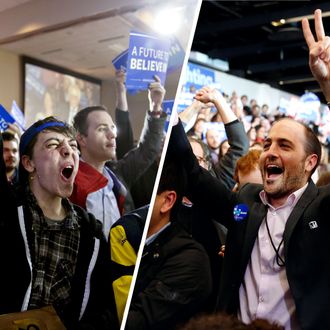
The race between Bernie Sanders and Hillary Clinton is a contest between radical and incremental visions of progressive change. The Vermont senator wants the Democratic Party to make a clean break with Third Way politics and bring Nordic social democracy to America. The former secretary of State aims to reunite the Obama coalition, secure the gains of the last eight years, and make gradual progress on unrealized aspects of the president’s agenda.
Many pundits have argued that these competing visions separate the party’s pragmatists from its idealists, its moderates from its ideologues. But Monday’s caucus results suggest that the party is primarily divided along a more material fault line.
Although Sanders exceeded Barack Obama’s margin of victory with younger voters, he still underperformed the president in Iowa’s liberal college towns. Although some predicted that Sanders would need to run up high margins of victory in the state’s urban areas to compensate for weakness in its rural ones, the democratic socialist ended up losing the Des Moines metro area and winning the conservative region along the Nebraska border. Obama, who was also branded as an “idealist” candidate, won the city but the lost the countryside.
As the Upshot’s Nate Cohn argued, the dividing line in Iowa was primarily economic. Clinton won 55 percent of voters who make upward of $100,000 a year but only 41 percent of voters who make below $30,000. Lest you think that disparity was driven entirely by Sanders’s hordes of incomeless college students, Cohn notes that the divide persists even when controlling for age: “Among voters over age 30, she won those making more than $100,000 by a 31-point margin, more than twice her 14-point lead among those making less,” he writes.
A similar class divide surfaces in polls of New Hampshire and nationwide. What’s more, although the socialist candidate does tend to poll well among those who identify as “very liberal,” some polls have found Sanders outperforming Clinton with self-identified moderates.
Of course, there’s still a lot of voting left to be done. But if class proves to be a greater dividing line than ideology in this race, it’ll point to an inherent flaw in the “pragmatists versus purists” narrative: Pragmatic decision-making is based on cost-benefit analysis, and some Democrats have less to lose than others do. Which is to say, the more dire the status quo is for an individual, the more appealing radical change will sound, regardless of whether one’s instincts are pragmatic or idealistic.
The Obama recovery looks very different to the upper and lower middle classes. For most of the current expansion, the bottom 90 percent of workers saw their inflation-adjusted incomes fall, while the top 10 percent have seen significant gains. This divergent perspective was well illustrated by a recent New Yorker piece that called on millennial Sanders supporters to confront the immaturity of their “purity” politics. In her op-ed, Alexandra Schwartz suggested that the 2008 crisis occupied an oddly prominent place in Sanders’s campaign rhetoric, writing:
“When I graduated from college, unemployment was close to ten per cent; it’s now at five. Sanders’s attention to socioeconomic justice is stirring and necessary, but when his campaign tweets that it’s “high time we stopped bailing out Wall Street and started repairing Main Street,” you have to wonder why his youngest supporters, so attuned to staleness in all things cultural, are letting him get away with political rhetoric that would have seemed old even in 2012.”
Of course, the economy as a whole is much improved from where it was in 2008. But this is far more true at the top of the income scale than it is at the bottom. As liberal economist Dean Baker notes, many workers still haven’t recovered from the crisis — which is to say, some workers still haven’t returned to being workers. Even though the unemployment rate dipped below 5 percent today, the workforce participation rate among prime-age workers is still three points below prerecession levels. Further, labor’s share of profits still hasn’t returned to where it was before the crisis.
When one takes into account this disparate experience of the recovery, it starts to make more sense that the affluent suburbs of Des Moines would have less appetite for revolution than less historically “liberal” but more broke regions of Iowa.






























